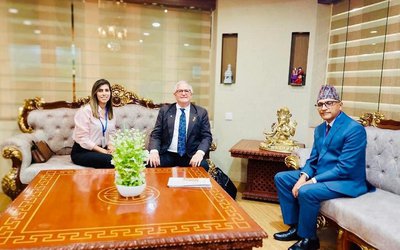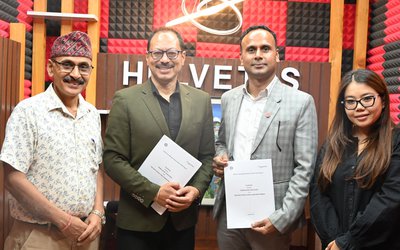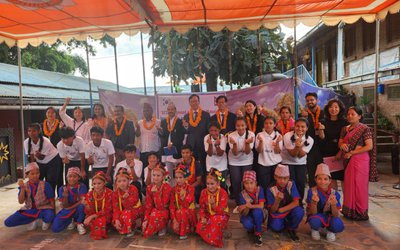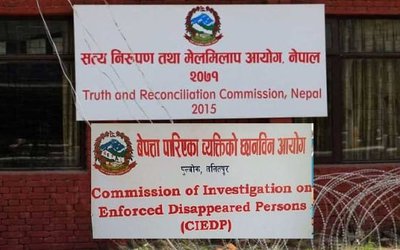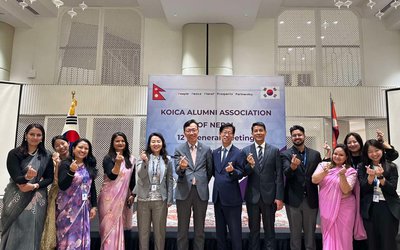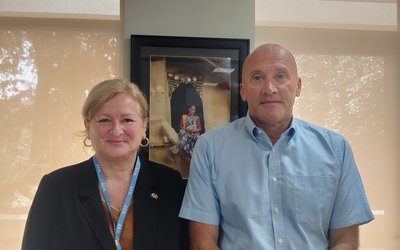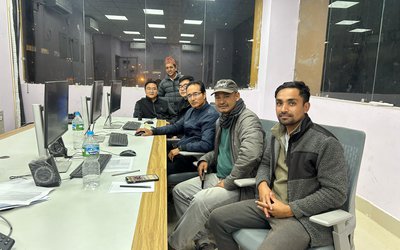
While walking along Maharajgunj and Chabahil, the two most busy roads of Kathmandu Valley, everyone can notice workers laying the underground cables of Nepal Electricity Authority (NEA).
NEA started its first phase of the underground electrical distribution system by laying down the power wires in Kathmandu in2019. Some 250-km, 11,000-voltage underground lines and 400-km, 400 voltage underground lines are now being laid down in Baluwatar, Panipokhari, Budhanilkantha, Tokha, Gongabu, Samakhusi and Maharajgunj that fall under the purview of Maharjgunj distribution center.
Likewise, 200-km long 11,000-voltage underground lines and about 400-km 400-voltage underground lines are being laid in some places including Ratnapark and Bagbazar.
This is not the only aspect of transformation. NEA has also started the installation of smart meters in Kathmandu Valley. Staring from Budhanilkanth Municipality, NEA has entered the digital meter era.
Under its first phase program, NEA has already changed 8222 Time off Day Meters to smart devices. Under the second phase, over 125000 meters will be replaced by smart meters. Some 18000 have already been installed and the other 60,000 are under the process. The project will replace 400000 old meters by smart meters in Kathmandu Valley; the tender process has already proceeded.
The constructions of 220 kV Marsyangdi Transmission linking Kathmandu and distribution system to 132 kV and other transmission lines and distribution systems, which are currently going on, indicate that a major transformation is taking place in NEA’s Power Transmission and Distribution centers aimed at enhancement of efficiency.

With financial assistance of over $555 million by the Asian Development Bank, NEA has been modernizing its entire system in the Kathmandu Valley and other parts of the country.
The power utility has stated that it has advanced the smart grid system to modernize the power sector of Nepal by introducing the latest technology that has been adopted globally to make power generation, transmission lines and distribution systems reliable and timely.
Speaking at a webinar recently, NEA Acting Managing Director, Hitendra Dev Shakya, said that work has already started by promoting the concept of a smart grid system for quality and reliable energy.
According to Shakya, the authority has moved ahead by digitizing its infrastructure and services. "As soon as we install the smart grid system, we will be able to provide quality electricity service to consumers and NEA’s system will also be strengthened. We are modernizing the entire system of NEA, including, transmission lines, distribution and load dispatch centers and power generation," he said.

With the new technology installed, consumers have also started to complain about NEA’s failure to repair and maintain the systems. In the last two months, NEA’s Maharagunj Distribution System received a lot of complaints related to smart meters.
The solution is simple. But in the absence of adequate technicians with skills, there happens to be a delay in maintenance work.
“If there is no technician to fix the smart meters, return the old meters to the customers,” said Bal Krishna Shrestha, chairperson of ward 3 of Budhanilkantha Municipality. This indicated the need for an upgrade of NEA’s technical capacity.
NEA’s Capacity Building
With the completion of underground cabling and the introduction of new smart technology and expansion of distribution and transmission system, NEA will have to operate in an entirely new way. However, successfully handling these systems depends on the capacity of NEA’s employees.
For all this, there is a need to up-skill managers, deputy managers, engineers and heads of distribution centers, and other technical and non-technical staff at NEA who are involved in day-to-day operations and project implementation. There is a need of knowledge and expertise on modern utility management practices and tools at the bottom and new skills at the top.
From carrying a ladder in the maintenance of old systems, the new system will be governed by a smart mobile phone. Similarly, smart meters mean smart payment without meter readers.

Having worked for decades in the old technology, based on semi-mechanical systems, and managing the small load with limited electricity grid with around 800 MW generation capacities, NEA will have to manage over 2000 MW power by next year.
NEA’s transmission and distribution system is 133 kV, 66 kV,33 kV and11 kV, with single-phase and double phase, for distribution. They have now to handle 220 kV. With all these, there is the need for orientation for the staff from the top to the bottom rung for communication of all these changes.
Training and other exercises that enhance the capacity of NEA staff to operate the new system inclusively, effectively and efficiently are pre-requisite.
Conducted by highly qualified and experienced national and international consultants, NEA’s employees have been currently taking training exercises on technical, managerial and Gender Equality and Social Inclusion issues.
Administered by ADB with support from Japan Fund For Poverty Reduction in close coordination with NEA, Humanist Institute for Co-operation with Developing Countries (Hivos), Netherlands along with its consortium Centre for Rural Technology, Nepal (CRT/N), Nepal, Practical Action Consulting (PAC Pvt), Nepal, and Ricardo-AEA Ltd (R-AEA), UK have been selected as consulting firms to provide services for the TA. Ricardo’s team of international experts, with support from CRT/N delivered the technical and managerial training for NEA. National Association of Community Electricity Users Nepal (NACEUN) is the strategic partner for the project.
As the training is in the initial stage, it is yet to make a bigger impact on NEA’s employees, particularly on institutional development and digitalization of the systems.
Experiences of NEA
Madan Timsina, the spokesperson of NEA, holds the view that the recent efforts of the Asian Development Bank and NEA to provide the training to enhance the capacity of employees are the key to a successful transformation. “The ongoing short term training and exercise with high-level experts from different parts of the world is a good beginning to prepare our employees for operation of the new system and work in the changing global scenario,” said Timsina, who also participated in a senior executive A exercise last year.
“The high-level exercise helped us learn the contemporary management procedures of public utility and service delivery around the world and the technical knowhow of smart systems. NEA’s employees need to understand the technology to work in the new system.”
As the main objective of NEA as a power sector utility is to satisfy its consumers with a continuous, reliable and quality supply of electricity as well as to maintain reasonable financial returns for further development, the employees also need to be prepared for this.

“We emphasize the fast deployment of automation and digitization in our businesses. The use of an automation system to monitor, control and manage the power system from Nepal Electricity Authority generation to distribution network shall be our priority at the doorstep for facilitating the reduction of operational cost and providing better services to our valued customers. We strongly feel that some policy measures are to be introduced on an urgent basis in this regard so that our journey from digitization to digitalization would prove beneficial in several ways including saving through operational efficiency and transparency across the value chain to all players in the power ecosystem,” writes outgoing MD Kul Man Ghising in his message given to NEA’s Annual Report of 2020 published in August.
Having worked at NEA for a long, Manoj Silwal, Deputy Managing Director, Project Management Directorate, said that ADB’s overall support including for the training and interactions, bringing high-level experts from different parts of the world, is highly relevant and helpful in the present context.
Prabal Adhikari, Director of Power Trade Department and former spokesperson, said that sharing the global experiences with experts enhanced capacities to address the new challenges. He said that NEA is in the process of modernization and transformation of infrastructure.
Lila Aryal, deputy director at Bagmati Province expressed that the training exercise helped her to understand the new technology and managerial skill. Aryal, who participated in the week-long executive training course, said modern technology and smart devices will bring about a different scenario.
“Initially, we had confusions about the courses. However, I found it was very useful to acquire new managerial skills applicable to the public utility like our organization.”
With the intervention aimed at building the capacity of top executive officers to the middle level managerial and junior engineers and other administrative staff of distribution centers, formidable numbers of employees have already been trained.
“To date, we have trained102 staff at level 9and above as a part of the managerial training program and another106 staff from 53 distribution centers trained in new and emerging energy technologies pertinent to NEA.,” said Mohammad Arbaaz Nayeem, Associate Director, Energy Practice, Ricardo Energy & Environment.
“Developed on the basis of needs assessment for both the management and technical staff, the training courses addressed the key knowledge gaps and issues identified by NEA managers and technical staff.”
Although it has just started, the training program looks like it is going to deliver necessary sensitization, awareness, capacity building and up-scaling skills for the staff to handle the technologies currently in the process of installation.
“The training program has been designed by Ricardo’s energy sector experts to meet Nepal Electricity Authority’s ambitions for the development of the sector, including improving operational capacity to enable utilization of smart-grid technology. The comprehensive training program draws on international best practices and includes respected keynote speakers. The courses started in August and ran through to September 2019,” said Nayeem, Associate Director, Energy Practice, Ricardo Energy & Environment.
Training Course
The training is divided into two parts.
The first was the Management Training, for managers and employees of 10 and 11 levels and above. It started on 21 August and concluded on 6 September 2019. The content of the training included Negotiations and Public Communications, Key Performance Indicators, Finance and Tariffs.
Under unbundling sectors, the participants were briefed on international experiences; financial management; HR management, organizational change and financial instruments.
The management training aimed to develop institutional governance and utility management practices at NEA with a view to facilitating improved business planning, investment management and sector policy formulation. This also included NEA in operational and management performance improvement to deliver better services to customers and support the economic development of Nepal.“The course was intensive as it covered broadly,” said spokesperson Timsina.
“The training program has been designed by Ricardo’s energy sector experts to meet Nepal Electricity Authority’s ambitions for the development of the sector, including improving operational capacity to enable utilization of smart-grid technology. The comprehensive training program draws on international best practices and includes respected keynote speakers. The courses started in August and ran through to September 2019,” said Mohammad Arbaaz Nayeem, Associate Director, Energy Practice, and Ricardo Energy & Environment.
The second technical training concluded in February 2020. This was divided into modules: Module A and Module B. This training included 10 level and 9 level and lower engineers. The training content included Modern Network Planning and Design, Distribution and Transmission System Planning, Undergrounding of Utilities and Power and Distribution Transformers in Module A.
Likewise, Module B taught Smart Grid Technologies, Smart Grids, Smart Metering, Technologies and Applications, Geographic Information Systems and Variable Renewable Energy. Technology Experts Trevor Fry and John Snow from Ricardo conducted the training for106 NEA’s technical staff.
Deputy Managing Directors (DMD), directors, assistant directors and managers and deputy managers, joint directors, junior directors, heads of distribution centers and project managers, engineers, sociologists, environmentalists, and engineers from NEA’s various directorate attended the program.
“Although the training courses were designed on the basis of interactions with the employees and their needs, some participants went to the training with some confusion. Frankly speaking, I was very confused on the first day. My other colleagues also had similar views,” said deputy director Aryal.
“Every sector in the world is now progressing to new methods and ideas daily. Even for existence, every sector should confront, adapt and exercise new approaches to solving new problems, with new technology in new situations. We also need to move in a new direction. This kind of capacity building training is timely,” said Deepa Subedi, Engineer, and PMD. “We have to prepare ourselves to work in the whole new smart systems. This training gave us some hope.”

“Following my participation in the training, I came to believe that, adopting digital systems on the existing infrastructure, changing ways of working, adding talented and skillful employees, and modernizing IT systems will hasten transformation. The smart system helps to increase the observability and controllability of the power generation system from an operator point of view,” said Yam Kumari Gurung, DCS Lamjung. “With the new technology and infrastructures coming, there need to train manpower,” Gurung said.
“At a time when NEA has been transforming its structures, transmission and distribution systems with new technologies, only up skilled and trained NEA employees can help make it viable for electricity to improve the livelihood of women in the rural parts of Nepal,” said Dr. Purushottam Shrestha, Project Supervisor and Micro Finance Advisor, CRT/N in an interaction with media.
NEA’s system is modernizing its operating systems with digitalization. However, it will make no sense to the consumer until the employees of NEA start to deal with the consumers efficiently and effectively and NEA does not make itself inclusive.
“Despite making digitalization and adopting new technology, NEA’s employees and its systems remain there to operate with an old mindset. This training, which includes various components related to the protection of consumer interest and service delivery, aims to change it,” said Narayan Gyawali, Chairperson, NACEUN. “We are reaching to all the level of NEA’s structures to improve governance and delivery.”
Availability of energy in the grid and digitalization of systems alone is not enough. Only secure and efficient supply of electricity can bring the change in the livelihood of the people. “With the installation of smart technologies and new system within NEA, the time has come for organization and its employees to encourage women in rural areas to use electricity to improve livelihood,” said Manjari Shrestha, Renewable Energy professional, Practical Action Consulting (PAC Pvt), Nepal,
With the completion of the training activities for NEA, it is expected that NEA’s institutional capacity will go up with employees enhancing their capacity.
“We greatly appreciated the overall enthusiasm and commitment from the senior management and leadership teams at NEA that was displayed throughout the training programs to enhance capacity and make the institution inclusive and GESI friendly,” said Dr. Indira Shakya, Nepal GESI Expert, CRT/N.
According to NEA’s annual report 2020/021, NEA has been providing services to consumers through its 129 Distribution Centers (DC) spread all over the country to total 42, 17,710 consumers and increase of 7.88% over the last fiscal year.
From operating at annual costs of merely a few billion rupees, NEA’s annual turnover is likely to cross over 50 billion rupees in the coming years. With the declaration of the Nepal government to realize universal coverage of electricity for all by 2023, everything will have to change in NEA.
In the process of this major transformation in NEA’s generation, operation and distribution systems, enhance managerial skills as well as new skills at maintenance, distribution and customers’ level will be necessary.
Gyanu Bist, Communications Officer, CRT/N, holds the view that the training has given an up-skilling and capacity building opportunity to enhance the NEA’s employees in GESI, operation, consumer services and other sector as well.
“This program and the training needs assessment highlighted a significant number of areas where up skilling, training and capacity development would contribute to improved utility management and operations,” said Mohammad Arbaaz Nayeem, Associate Director, Energy Practice, Ricardo Energy & Environment.
As NEA has been going through a major transformation and expansion of its transmission and distribution services while introducing the new technologies and constructing new infrastructures in generation, transmission and distribution, everyone can notice the ongoing efforts.
However, the training aimed at building NEA capacity in new and emerging energy technologies and applications and NEA capacity in utility management to operate and maintain Kathmandu valley is going on quietly. This is a small but key part of making NEA efficient, inclusive and adaptive, to run the underground cable, smart transmission, distribution and meter system.

